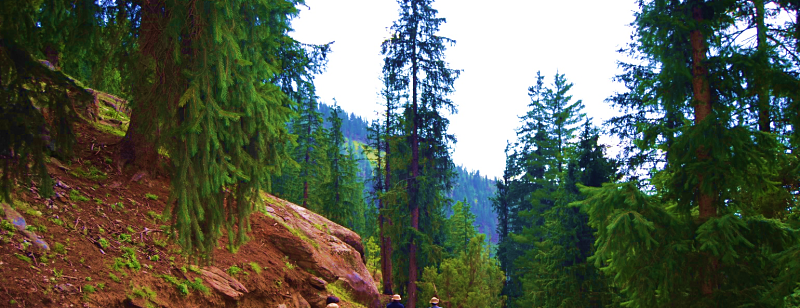Forest, Wildlife & Environment Department Government of Gilgit-Baltistan

Abies pindrow (Pinaceae)
Common name: Partal, Silver Fir.
Local name: Qachul
Description:
Trees to 60 m tall and 300 cm DBH, typically with a single straight, round trunk, short branches, and a narrow, conical crown. Bark first smooth and gray, becoming thick, gray-brown and longitudinally furrowed. Buds globose, large, and resinous. Twigs stiff, pinkish to pale brown, soon fading to pale gray, glabrous, lightly ridged, with circular leaf scars. Leaves spirally arranged but appearing roughly 2-ranked on shade foliage, the upper leaves somewhat shorter than the lower, 3-6 cm × 1.3-2 mm, twisted at base, flattened, grooved and dark green above, with 2 gray stomatal bands below; no stomata on upper surface; apex bifid or emarginate or obtuse, but acute on coning shoots. Pollen cones lateral, numerous, on the underside of shoots, 10-15 mm long, yellow-brown when active. Seed cones lateral, erect, on short peduncles, cylindrical with obtuse apex, 10-14 × 5-6 cm, first violet-blue, at maturity dark red-brown, with flabellate seed scales 25-35 × 30-40 mm having a slightly striated surface and entire upper margin; bracts hidden. Seeds 10-12 long with a 15-20 mm brown wing.
Distribution and Ecology
Gilgit, Astore and Diamer District of Gilgit-Baltistan and widely throughout the western Himalaya, in Afghanistan, Pakistan, India, and Nepal, at elevations of 2000-3300(-3700) m; the climate is monsoonal, cool and moist, increasingly snow-dominated from the western to eastern range limits. Occurs in pure stands, but is also often codominant with Pinus wallichiana, Picea smithiana, or Cedrus deodara, and less frequently occurs with Tsuga dumosa; at lower elevations broadleaf angiosperms become progressively dominant, replacing the conifers at elevations below 1600 m (Vidakovic 1991; Farjon 2010; Siddiqui et al. 2013, 2015). Bioclimatic modeling of an area in Pakistan indicates that global climate change is likely to lead to future reductions in the species (Ali et al. 2014 ). Hardy to Zone 8 (cold hardiness limit between -12.1°C and -6.7°C) (Bannister and Neuner 2001).
